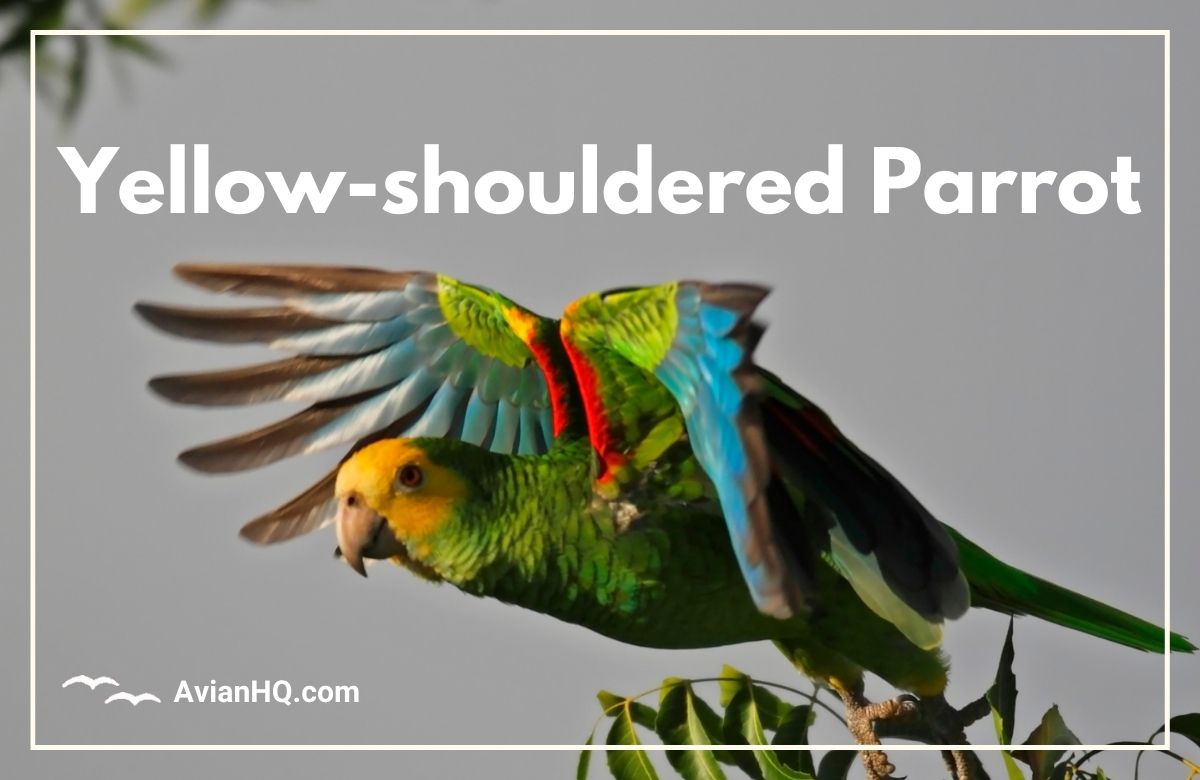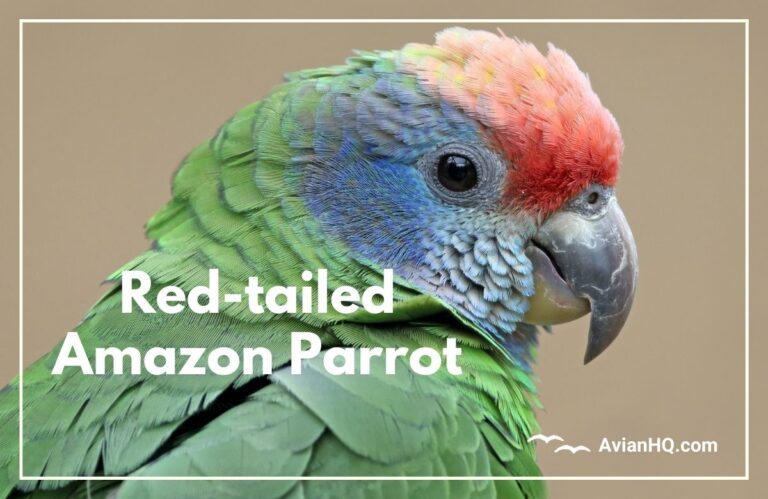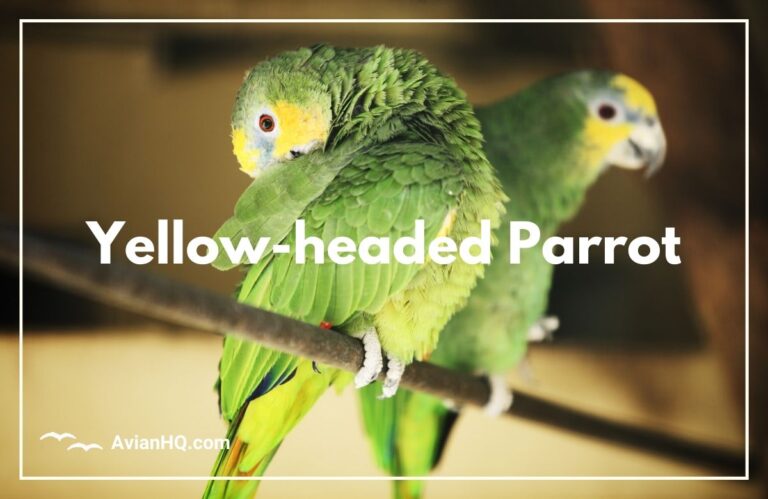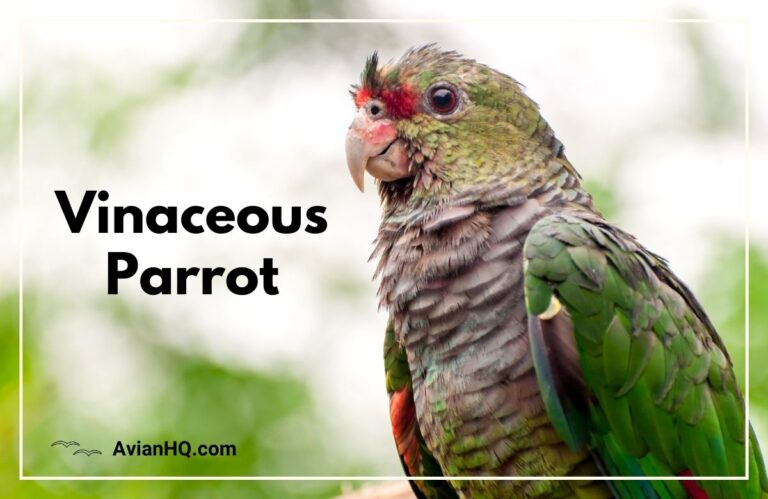Yellow-shouldered Parrot (Amazona barbadensis)
Have you ever seen a flash of green and yellow feathers and wondered what tropical bird made it’s home nearby? If you live in northern coastal Venezuela or on certain Caribbean islands, it may well have been the Yellow-shouldered Amazon Parrot, Amazona barbadensis. This beautiful parrot with a musical call stands out with it’s bright plumage. Yet it blends into and depends on the desert scrub and dry forests that make up it’s arid habitat.
You’ll most often find the Yellow-shouldered Parrot in Venezuela’s Falcón and Sucre states as well as Margarita Island and other offshore islands. But thanks to cage bird trade, you may spot these parrots elsewhere if they escaped or were released. The species has adapted to the hot, dry conditions found in thorn forests and deserts dotted with cacti and low shrubs. It roams across a range of 0 to 1,476 feet (0 to 450 m) in elevation.
Weighing in at just under 10 ounces (270 g), the Yellow-shouldered Parrot grows to be 13 inches (33 cm) from beak to tail tip. It’s bright green feathers contrast with a white forehead, yellow-orange shoulders, and blue-tinged wings and tail. The parrot’s curved bill matches the color of light horn. Peer into it’s face framed by white rings around each eye, and you’ll often see feather colors of yellow, blue or both.
This small Amazon parrot has a bigger-than-life presence wherever it flies. It’s bright hues and squeaky chattering carry far across it’s arid homeland. The Yellow-shouldered Parrot depends on desert plants like cacti for food and shelter. And it’s limited numbers depend in turn on protection from trapping for the pet trade plus preservation of it’s delicate dry forest habitat.
History and Taxonomy
The first written account of the Yellow-shouldered Amazon Parrot came from English naturalist Eleazar Albin in 1738. Albin illustrated the bird in his book A Natural History of Birds and called it the “Barbadoes parrot” since he believed it came from Barbados. However, the parrot does not actually live on Barbados. It’s true native range is a narrow coastal region of Venezuela and several nearby islands.
In 1788, the German naturalist Johann Friedrich Gmelin gave the parrot the scientific name Psittacus barbadensis when he updated Carl Linnaeus’ authoritative volumes on species classification. The barbadensis part of the name refers to the mistaken Barbados origin. Over time, taxonomists moved the yellow-shouldered parrot to it’s current genus Amazona. This name comes from a French naturalist who thought these birds lived in the Amazon rainforest.
No distinct subspecies of the Yellow-shouldered Amazon are recognized today. All populations show very similar size, plumage, behaviors and genetics. Their color patterns do vary to some degree among individuals and island groups. But scientists have not found clear differences to define separate subspecies.
The Yellow-shouldered Amazon remains the only Amazona parrot adapted to desert habitats. It carved out a niche on the arid islands and coastline, separate from all it’s rainforest-dwelling relatives. This separation shaped many unique behaviors and survival strategies that set it apart. Yet it’s bright beauty and vocal talents still link it to other parrots in the Americas.
Physical Appearance
The Yellow-shouldered Amazon Parrot is a medium-small parrot measuring about 13 inches (33 cm) from the tip of it’s tail to the end of it’s bill. It typically weighs between 9 and 10 ounces (270 g). This gives it a more slender and light body type compared to some of it’s larger and chunkier Amazon relatives.
Bright green feathers cover most of the parrot’s body, with some variation to more blue-green on the chin, cheeks, and belly. The forehead and the narrow bands of feathers around the eyes are white. Moist skin around the eyes matches the white eye rings in color. A bright splash of golden feathers tints the crown and the sides of the head.
The parrot’s namesake yellow “shoulders” appear on the bend of each wing, trimmed in red. Yellow also frequently occurs on the ear coverts, chin, and upper throat. The wing flight feathers or remiges have vivid blue tips. When spread in flight, these blue flashes contrast with a scarlet-red patch along the wings known as the speculum.
The tail feathers display an elegant pattern of yellowish green transitioning to deeper green approaching the tip. The exterior tail feathers in particular curve gracefully behind the parrot. The sturdy but delicate bill matches a light tan horn color. The feet and zygodactyl toes follow the same scheme, blending tan and gray.
Males and females have identical plumage. They display no sexual dimorphism in their appearance. Juveniles look much like adults but often show some barring effects until their first molt. The young parrots also start with brown irises that change to a fiery orange-red as they mature.
Habitat and Distribution
The Yellow-shouldered Amazon inhabits a very specific type of habitat restricted to northern coastal Venezuela and nearby islands. It’s native range centers on Falcón and Sucre states on the Venezuelan mainland. Offshore, you’ll find it on Margarita Island as well as La Blanquilla, part of Los Testigos Islands.
This parrot species specializes in arid environments. It thrives in desert scrub dominated by cacti and thorny bushes. You may also spot it frequenting dry forests, cultivated fields, and even mangrove stands. But it always stays fairly close to the coastline.
The Yellow-shouldered Amazon roams between sea level up to around 1,500 feet (450 m) in elevation on Margarita Island. Scientists believe it may range even higher in the nearby mountainous regions of mainland Venezuela. But most sightings occur at lower elevations.
Thanks to the caged bird trade, small introduced populations took hold on the islands of Curaçao and Aruba. However, habitat loss and trapping caused the parrot to go extinct on Aruba by 1947. Conservation efforts aim to restore sustainable wild populations. But habitat protection remains vital for this species with such narrow habitat requirements.
Diet and Feeding
The Yellow-shouldered Amazon is well adapted to take advantage of the sparse vegetation in it’s desert environment. It employs an opportunistic foraging strategy, feeding on a variety of fruits, seeds, flowers, and cacti. This gives it a diverse diet that changes with the seasons.
Fruits the parrot favors come from thorny trees and shrubs in the desert scrub habitat. These include the fruits of species in the caltrop family as well as from acacia and mesquite trees. The parrots use their strong bills to open hard seed pods. They extract nutritious seeds from inside the pods, destroying the pods in the process.
Sweet nectar drawn from blossoms of desert plants also provides an important food source. And the parrot makes especial use of cacti during the dry season when other plants go dormant. It feeds readily on cactus flowers, fruits, and pulp. The moisture content gives vital hydration to supplement the parrot’s limited drinking water.
To feed, these parrots employ a variety of behaviors suited to harvest specific food items. They cling acrobatically to cactus stems and fruits using their zygodactyl feet with two toes pointed forward and two back. The birds hang or carefully balance to pick and nibble on prickly pears or cardón cactus flowers. Their tendency to feed in small flocks may help watch for dangers posed by predators while eating.
Breeding and Reproduction
The Yellow-shouldered Amazon mates and breeds during the rainy season from March to September. In years when rains extend longer, nesting activity may continue into October. By choosing this time to nest, the parrots take advantage of peak food availability to feed their chicks.
Nest sites get established in natural cavities or crevices within trees, cliff faces, or columnar cacti. The female typically lays a clutch of 2-5 eggs in the protected cavity. She incubates the eggs alone for 24-26 days before they hatch.
Both parents share dutifully in feeding and caring for the hatchlings over the next 10-12 weeks. As the chicks grow flight feathers and build flight muscle strength, they eventually fledgle the nest at around 70-85 days old. However, the parents continue to supplement feed and teach survival skills for some time after fledging.
In years with ample rainfall, this species shows very high breeding success. Studies on Margarita Island revealed this parrot has among the largest average clutch sizes and best hatching rates known for the genus Amazona. This high reproductive potential suggests room for population growth if the parrots have access to suitable nest sites and foraging resources.
The problem comes from young poached from nests amid competition for scarce habitat. Protecting breeding and roosting sites grows ever more vital for the Yellow-shouldered Amazon’s future. Only then can it’s high reproductive potential be translated into growth of wild populations.
Behavior and Ecology
The Yellow-shouldered Amazon exhibits behavioral adaptations that allow it to thrive in it’s hot, arid environment. This highly social parrot gathers in large communal roosts, especially outside of breeding season. Flocks may contain anywhere from a dozen to as many as 700 individuals.
These large gatherings likely help the parrots in multiple ways. Roosting together offers safety in numbers against predators like hawks or snakes. Shared vigilance while foraging may also detect dangers sooner. And information on the location of scarce food and water resources gets communicated efficiently through the flock.
During the heat of the day, the parrots reduce their activity to conserve both energy and moisture. But early mornings and late afternoons bring busy periods of flight and foraging. The parrots cover distances up to 18 miles (30 km) in their daily travels between nesting, roosting, and feeding areas.
In addition to feeding behaviors like clinging acrobatically while picking cactus fruits, the parrots show some unusual behaviors. Several accounts describe them rolling onto their backs quite uncharacteristically to interact with enrichment items. And their vocal repertoire stands out as higher pitched compared to most other Amazona species.
The Yellow-shouldered Amazon continues to adapt well to the challenging and changing environment of Venezuela’s arid northern coastal region. But threats from human activity increasingly pressure the species. Only through expanded education and conservation efforts can this unique desert parrot maintain it’s fragile niche.
Conservation Status
The Yellow-shouldered Amazon faces a precarious future as development and habitat loss chips away at it’s specialized environment. The International Union for Conservation of Nature (IUCN) Red List categorizes the species as Vulnerable based on it’s limited range and multiple intensifying threats.
Best estimates put the global wild population at 2,500-10,000 mature individuals. However, some localized populations saw declines of over 30% in recent decades. Without expanded conservation action, the outlook remains uncertain for this rare parrot.
On Margarita Island, the parrot population dwindled to around just 750 birds in 1989 due to land development and trapping. Focused conservation initiatives helped numbers rebound to approximately 2,400 by 2002. But habitat loss continues, putting the gains at risk.
Several key factors drive the Yellow-shouldered Amazon’s threatened status. Destruction of nesting and feeding habitat poses problems across it’s range. Capture for the caged bird trade also persists despite legal protections. Feral animal predation and conflict with farmers add further complications.
Concerted efforts to ward off these threats have achieved some success. These include habitat restoration projects, crack-downs on poaching, captive breeding initiatives, and outreach campaigns. But for the long term, engagement and support from local communities remains the most vital ingredient for the conservation recipe.
The path ahead remains full of challenges for the survival of the Yellow-shouldered Parrot. But with care and dedication, this bird still has the potential to brighten northern Venezuela with it’s brilliant colors for decades to come.
Cultural Significance
The bright colors and animated nature of the Yellow-shouldered Amazon make this parrot a natural flagship species for it’s home region of northern Venezuela. As the unique wildlife living alongside local communities, the parrot carries important cultural symbolism.
The government of Nueva Esparta State in Venezuela officially designated the Yellow-shouldered Parrot as the state’s Regional Bird. This status aims to promote pride, awareness, and stewardship for the parrot among residents and visitors.
Outreach programs on Margarita Island incorporate the beloved parrot into environmental education activities. A “Teacher’s Guide” for conserving the species helps instruct young generations. Annual festivals celebrating the parrot also bring the community together in support.
During the breeding season from March–August, groups of local youths band together to guard parrot nesting areas. These “EcoGuardians” put themselves at risk confronting illegal poachers and trappers around La Chica creek. Their dedication speaks to the levels of cultural connection felt between locals and “their parrot.”
By serving as an ambassador to it’s species and the dry tropical forests it inhabits, the Yellow-shouldered Amazon boosts chances for conservation success. People protect what they love and find meaningful. So elevating this parrot’s stature in local culture may ensure it’s environmental needs get addressed. Any future for the parrot lies intertwined with respect from surrounding communities.
Conclusion
The Yellow-shouldered Amazon Parrot stands out as the only member of it’s genus adapted to arid regions. Over time, it evolved to thrive in the desert scrubs and dry forests of Venezuela’s northern coast and islands. This specialty niche supports smaller populations than many relatives. But it also leaves the species vulnerable to any habitat disruptions.
With it’s bright green plumage accented in shades of blue, yellow, and red, this parrot embodies the vibrant beauty of it’s tropical homeland. Yet trafficking pressure from the pet trade and habitat loss to development dim the future prospects. Support from local communities holds the key to preserving populations.
Conservation efforts for the Yellow-shouldered Amazon have achieved some initial successes. But continued progress relies on habitat protection, enforcement of protections, and engaging future generations. The outlook remains challenging for this rare species living on the fringe. Sustained commitment to it’s cause can help ensure this desert jewel continues shining for the world to admire.
With around 33 cm (13 in) in body length, half the Yellow-shouldered Amazon’s beauty flows from it’s graceful proportions on a petite frame. This petite parrot may yet prove to have giant resilience allowing it to overcome the existential threats it now faces down.







